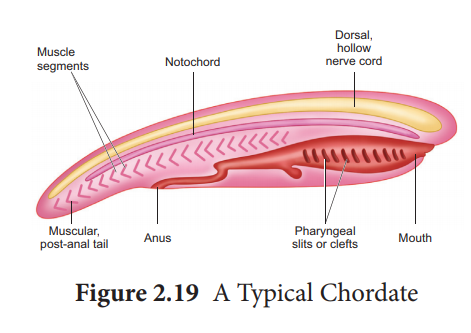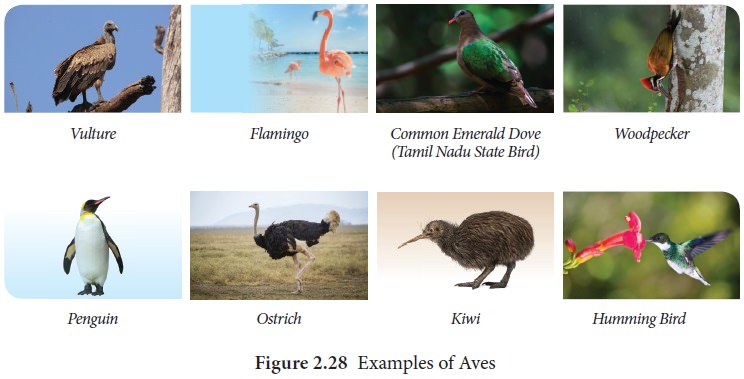Chapter: 11th Zoology : Chapter 2 : Kingdom Animalia
Phylum: Chordata

Phylum: Chordata
(G. Chorda –string)
Chordata
is the largest phylum with most familiar group of animals, such as fishes,
amphibians, reptiles, birds and mammals and less known forms such as lancelets
(Amphioxus) and tunicates (Ascidian). All chordates possess three fundamental
distinct features at some stage of their life cycle (Figure 2.19), they are:
1.
Presence of elongated rod like notochord below the
nerve cord and above the alimentary canal. It serves as a primitive internal
skeleton. It may persist throughout life in lancelets and lampreys. In adult
vertebrates, it may be partially or completely replaced by backbone or
vertebral column.
2.
A dorsal hollow or tubular fluid filled nerve cord
lies above the notochord and below the dorsal body wall. It serves to integrate
and co-ordinate the body functions. In higher chordates, the
anterior end of the nerve cord gets enlarged to form the brain and the
posterior part becomes the spinal cord, protected inside the vertebral column.
3.
Presence of pharyngeal gill slits or clefts in all
chordates at some stage of their lifecycle. It is a series of gill slits or
clefts that perforates the walls of pharynx and appears during the development
of every chordate. In aquatic forms, pharyngeal gill slits are vascular,
lamellar and form the gills for respiration. In terrestrial chordates, traces
of non-functional gill clefts appear during embryonic developmental stages and
disappear later. Besides the above said features, chordates are bilaterally
symmetrical, triploblastic, coelomates with organ system level of organisation;
they possess post anal tail, closed circulatory system with a ventral myogenic
heart except in Amphioxus.


1. Subphylum:
Urochordata or Tunicata
(G. Oura – A tail; L. Chord – cord)
They are
exclusively marine and are commonly called sea squirts. Mostly sessile, some
pelagic or free swimming, exist as solitary and colonial forms. Body is
unsegmented and covered by a test or tunic. Adult forms are sac like. Coelom is
absent, but has an atrial cavity surrounding


Notochord is present only in the tail region of the larval stage,
hence named urochordata. Alimentary canal is complete and circulatory system is
of open type. The heart is ventral and tubular. Respiration is through gill
slits and clefts. Dorsal tubular nerve cord is present only in the larval stage
and a single dorsal ganglion is present in the adults. Mostly hermaphrodites,
development indirect and includes a free swimming tadpole larva with chordate
characters Retrogressive metamorphosis is seen (Figure
2.21).
Examples: Ascidia, Salpa,
Doliolum
2. Subphylum: Cephalochordata
( L. Cephalo- ‘head’ ;
G. chorda ‘cord’.)Cephalochordates are marine forms, found in shallow waters, leading a burrowing
mode of life. They are small fish like coelomate forms with chordate characters
such us notochord, dorsal tubular nerve cord and pharyngeal gill slits
throughout their life. Closed type of circulatory system is seen
without
heart. Excretion is by protonephridia. Sexes are separate, Fertilization is
external. Development is indirect and includes a free swimming larva (Figure
2.22).
Example: Branchiostoma
(Amphioxus or lancelet)

3. Subphylum-Vertebrata
(L. Vertebrus –back
bone )
Vertebrates
are also called higher chordates and they possess notochord during embryonic
stage only. The notochord is replaced by a cartilaginous or bony vertebral
column in the adult. Hence all
vertebrates are chordates but all chordates are not vertebrates.
Vertebrates possess paired appendages such as fins or limbs. Skin is covered by
protective skeleton comprising of scales, feathers, hairs, claws, nails, etc.
Respiration is aerobic through gills, skin, buccopharyngeal cavity and lungs.
Vertebrates have a ventral muscular heart with two, three or four chambers and
kidneys for excretion and osmoregulation.
Subphylum
Vertebrata is divided into two divisions, Agnatha
and Gnathostomata. Agnatha includes
jawless fish-like aquatic vertebrates without paired appendages. Notochord
persists in the adult. Gnathostomata includes jawed vertebrates with paired
appendages. Notochord is replaced partly or wholly by the vertebral column.
Agnatha includes one important class – Cyclostomata. Gnathostomata includes
jawed fishes (Pisces) and Tetrapoda ( amphibia, reptilia, aves and mammals).
The superclass Pisces includes all fishes which are essentially aquatic forms
with paired fins for swimming and gills for respiration. Pisces includes
cartilaginous fishes (Chondrichthyes) and bony fishes (Osteicthyes).
4. Class: Cyclostomata
(G.cyklos–circle; stomata -mouth)
All
members of cyclostomata are primitive, poikilothermic, jawless aquatic
vertebrates and are ectoparasites on some fishes. Body is slender and eel-like
bearing six to fifteen pair of gill slits for respiration. Mouth is circular without jaws and suctorial. Heart is two
chambered and circulation is of closed type. No paired appendages. Cranium and
vertebral column are cartilaginous. Cyclostomes are marine but migrate to fresh
waters for spawning (anadromous migration). After spawning within a few days
they die. The larvae (ammocoete) after metamorphosis returns to the ocean.
Examples: Petromyzon (Lamprey) and Myxine (Hag fish) (Figure 2.23).

5. Class:
Chondrichthyes
(G. chondros –cartilage; ichthys -fish)
They are
marine fishes with cartilaginous endoskeleton. Notochord is persistent
throughout life. Skin is tough covered by dermal placoid scales and the caudal fin is heterocercal (asymmetrical both externally and internally). Mouth
is located ventrally and teeth are
modified placoid scales which are backwardly directed. Their jaws are very
powerful and are predaceous animals. Respiration by lamelliform gills without
operculum (gill cover). Excretory organs are mesonephric kidneys. Two chambered
heart is present. Cartilaginous fishes are ureotelic and store urea in their
blood to maintain osmotic concentration of body fluids. They are poikilothermic
and viviparous. Sexes are separate. In males pelvic fins bear claspers to aid in
internal fertilisation.
Examples: Scoliodon
(Shark), Trygon (Sting ray), Pristis (Saw fish) (Figure 2.24).

6. Class: Osteichthyes
(G. osteon –bone; ichthys -fish)
It
includes both marine and freshwater fishes with bony endoskeleton and spindle
shaped body. Skin is covered by ganoid, cycloid or ctenoid scales. Respiration
is by four pairs of filamentous gills and is covered by an operculum on either
side. Air bladder is present with or without a connection to the gut. It helps
in gaseous exchange (lung fishes) and for maintaining buoyancy in most of the
ray finned fishes.
They have
a ventrally placed two chambered heart. Excretory organs are mesonephric
kidneys and are ammonotelic. Presence of well developed lateral line sense
organ. Sexes are separate, external fertilization is seen and most forms are
oviparous (Figure 2.25).

Examples:
Exocoetus (Flying fish), Hippocampus (Sea horse), Labeo (Rohu), Catla (Catla), Echeneis
(Sucker fish), Pterophyllum (Angel
fish)
7. Class: Amphibia
(G. amphi-both; bios -life)
Amphibians
are the first vertebrates and tetrapods to live both in aquatic as well as
terrestrial habitats.They are poikilothermic. Their body is divisible into the
head and trunk and most of them have two pairs of limbs; tail may or may not be
present. Their skin is smooth or rough, moist, pigmented and
glandular. Eyes have eyelids and the tympanum represents the ear. Respiration
is by gills, lungs and through the skin. Heart is three chambered. Kidneys are
mesonephric. Sexes are separate and fertilization is external. They are
oviparous and development is indirect. They show hibernation and aestivation.
Examples:
Bufo(Toad), Rana(Frog), Hyla(Tree
frog), Salamandra (Salamander), lcthyophis (Limbless amphibians) (Figure
2.26).

8. Class: Reptilia
(L.
repere or reptum – to creep or crawl)
They are
mostly terrestrial animals and their body is covered by dry, and cornified skin
with epidermal scales o scutes. Reptiles have three chambered heart but four
chambered in crocodiles. All are cold blooded amniotes (poikilotherms). Most
reptiles lay cleidoic eggs with extraembryonic membranes like amnion,
allantois, chorion and yolk sac. Excretion by metanephric kidneys and are
uricotelic. They are monoecious. Internal fertilization takes place and all are
oviparous.
Examples : Chelone
(Turtle), Testudo (tortoise), Hemidactylus (House lizard), Chameleon (Tree lizard), Calotes (Garden lizard), Draco (Flying lizard), Crocodilus (crocodile), Poisonous
snakes - Naja (Cobra), Bangarus (Krait), Vipera (Viper) (Figure 2.27).

9. Class Aves
(L. Avis –bird)
Aves are
commonly known as birds. The characteristic feature of Aves is the presence of
feathers and the ability to fly except for flightless birds (Eg. Ostrich, Kiwi,
Penguin). The forelimbs are modified into wings, and the hind limbs are adapted
for walking, running, swimming and perching. The skin is dry and devoid of
glands except the oil gland or preen gland at the base of the tail. The
exoskeleton consists of epidermal feathers, scales, claws on legs and the horny
covering on the beak. The endoskeleton is fully ossified (bony) and the long
bones are hollow with air cavities (pneumatic bones). The pectoral muscles of
flight (pectoralis major and pectoralis minor) are well developed.
Respirationisbycompact, elastic, spongy lungs that are continuous with air sacs
to supplement respiration. The heart is four chambered. Aves are homeothermic.
Migration and parental care is well marked. Urinary bladder is absent. Sexes
are separate with well marked sexual dimorphism. In males, the testes are
paired but in females, only the left ovary is well developed while the right
ovary is atrophied. All birds are oviparous. Eggs are megalecithal and
cleidoic. Fertilization is internal.
Examples Corvus (Crow), Columba (Pigeon), Psittacula
(Parrot), Pavo (Peacock), Aptenodytes (Penguin), Neophron (Vulture), Chalcophaps indica (Tamilnadu state bird, Common Emerald Dove) (Figure 2.28).

10. Class: Mammalia
(L. Mamma – Breast)
They are
found in a variety of habitats. Their body is covered by hair, a unique feature
of mammals. Some of them are adapted to fly or live in water. Presence of
mammary glands is the most unique feature of mammals. They have two pairs of
limbs adapted for walking, running, climbing, burrowing, swimming and flying.
Their skin is glandular in nature, consisting of sweat glands, scent glands and
sebaceous glands. Exoskeleton includes horny epidermal horns, spines, scales,
claws, nails, hooves and bony dermal plates. Teeth are thecodont, heterodont
and diphyodont. External ears or pinnae are present. The heart is four
chambered and possess a left systematic arch. Mature RBCs are circular,
biconcave and non nucleated. Mammals have a large brain when compared to other
animals They show greatest intelligence among all animals. Their kidneys are
metanephric and are ureotelic. All are homeothermic, sexes are separate and
fertilization is internal.
![]()
Examples
Oviparous- Ornithorhynchus
(Platypus), Viviparous- Macropus
(Kangaroo), Pteropus (Flying fox), Macaca (Monkey), Canis (Dog), Felis (Cat), Elephas (Elephant), Equus (Horse), Delphinus (Common
dolphin) Balaenoptera (Blue whale), Panthera tigris (Tiger), Panther leo (Lion), Homo sapiens (Human) Bos (Cattle).

Related Topics